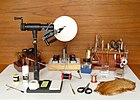User talk:Mike Cline/Articles Under Contemplation/Bucktail flies
| Mike Cline/Articles Under Contemplation/Bucktail flies | |
|---|---|
| Artificial fly | |
 Alaska Mary Ann Bucktail Streamer | |
| Type | Streamer patterns |
| Imitates | Baitfish |
| History | |
| Created | Frank Dufresne |
| Typical hooks | Streamer, 3X-4X long |
| Thread | Black |
| Tail | Red hackle fibers |
| Body | White yarn |
| Wing | Hair from Northern White-tailed deer tail or other long mammal hair |
| Ribbing | Silver oval tinsel |
| Uses | |
| Primary use | Trout, Warmwater, Saltwater species |
Bucktail flies, often called bucktail streamers, are a broad, generic group of sub-surface baitfish patterns used by fly anglers to imitate forage fish that are preyed upon by larger fish. The defining characteristic of both historic and contemporary bucktail flies is the use of long hairs from the tails of Northern white-tailed deer or other long hair from mammal species to create a long, winged fly. Bucktail styled flies tied for atlantic salmon and steelhead are often called Hair wing flies.[1]
History
[edit]Early accounts documented by Joe Brooks in Streamer Fly Fishing in Fresh and Saltwater (1950) relate that the Ona Indians of Tierra del Fuego used hair from Guanaco to craft crude bucktail flies by impaling a strip of hide with hair on a hook to catch fish in local waters. In the 1920s, Frank Dufresne, a U.S. Fish and Wildlife staffer working in Alaska, described an Eskimo fishing lure that used polar bear hair to take lake trout through the ice.[1] Dufresne later crafted a more modern version of the Eskimo lure that became known as the Alaska Mary Ann.
General description
[edit]Bucktails as a class of artificial flies have historically been defined by the use of bucktail (typically hair from northern white-tailed deer) or other long fibered mammal hair used to create winged baitfish patterns. Classic bucktails used only hair, yarn and tinsels in their construction but modern bucktails have evolved to include other fibers, feathers, synthetics, etc. Although a technical distinction, baitfish flies using feathers for wings have been traditionally called streamers. However, that distinction has faded and bucktail flies today are routinely referred to as streamers as well as bucktails. The classic bucktail has a tail and/or wing of hair and a body of various combinations of yarn, floss and tinsel. Classic bucktail flies are typically tied on 3X-4X long streamer hooks. Heads may or may not have painted eyes or eyes of Jungle cock.[1]
List of bucktail patterns
[edit]Historic patterns
[edit]As described in Streamer Fly Tying & Fishing (1950), Joseph D. Bates[2]
- Bumblepuppy - One of the earliest documented bucktail patterns designed by American angler Theodore Gordon in the 1880s.
- Black nosed dace - An Art Flick pattern
- Bucktail royal coachman
- Bucktail silver streamer
- Ray Bergman bucktail
- Mickey Finn
As described in Tying & Fishing Bucktails and Other Hair Wings (2016), Mike Valla[3]
- The Brooks Blondes (Argentina, Black, Honey, Pink, Platinum and Strawberry)
- A.S. Trudes (Red, Optic Variation, Green, Black, Black/Red)
- Brown and White Bucktail
As described in Carrie G. Stevens, Maker of the Rangeley Favorite Trout and Salmon Flies (2000) Graydon Hilyard[4]
- F.R.S. Special
- Reverse-tied Bucktail, freshwater style
- Reverse-tied Bucktail, saltwater style
- Shiner
Freshwater patterns
[edit]Saltwater patterns
[edit]General saltwater bucktails
[edit]Coastal cutthroat trout bucktails
[edit]- Bed and Breakfast
- Blair's Baiter
- Ferguson's Green and Silver
- Johnson's Beach Fly
- Lambuth Candlefish
- Puget Power
- Ray's Fly
- William's Point Sandlance
- Crystal Mickey
- Golden Needle
- Holder's Sea-through
- Red-tailed Hawk
Atlantic salmon bucktails
[edit]- Ally's Shrimp
- Atherton Squirrel Tail
- Big Intervale Blue
- Black Bear Green Butt
- Black Bomber
- Black Ghost
- Blue Smelt Streamer
- Blue Charm
- Copper Killer
- Cosseboom Special
- Grizzly King
- Laxa Blue
- Miramichi Special
- Rat (Blue)
- Rose of New England Streamer
- Tanner's Blue Smelt Streamer
- Warden Watcher
- Brad's Brat
- Chum fly
- Golden Demon
- Green Butt Skunk
- Kispiox Special
- McNeese Madness
- Pink Matuka
- Polar Shrimp
- Purple Brat
- Purple Peril
- Skunk
- Thor
- Umpqua Special
Notes
[edit]- ^ a b c Valla, Mike (2016). "Development and History of Bucktails". Tying & Fishing Bucktails and Other Hair Wings. Lanham, MD: Stackpole Books. pp. 3–26. ISBN 9780811716765.
- ^ Bates, Joseph D. (1966). Streamer Fly Tying & Fishing. Harrisburg, Pennsylvania: Stackpole Books.
- ^ Valla, Mike (2016). "Catalog of Bucktails". Tying & Fishing Bucktails and Other Hair Wings. Lanham, MD: Stackpole Books. pp. 148–178. ISBN 9780811716765.
- ^ Hilyard, Graydon; Hilyard, Leslie (2000). "Stevens Streamer Patterns". Carrie G. Stevens, Maker of the Rangeley Favorite Trout and Salmon Flies. Mechanicsburg, PA: Stackpole Books. pp. 125–153. ISBN 0811703533.
- ^ Johnson, Les (2004). "Coastal Cutthroat Flies". Fly-Fishing Coastal Cutthroat Trout: Flies, Techniques, Conservation. Portland, OR: Frank Amato Publishers. pp. 66–115. ISBN 978-1-57188-334-6.
- ^ a b Valla, Mike (2016). "Catalog of of Atlantic Salmon Hairwings and Steelhead Hairwings". Tying & Fishing Bucktails and Other Hair Wings. Lanham, MD: Stackpole Books. pp. 193–216. ISBN 9780811716765.











